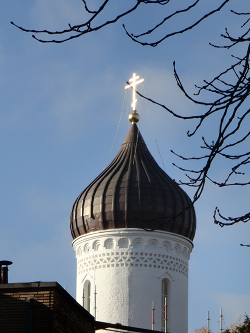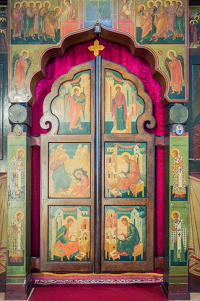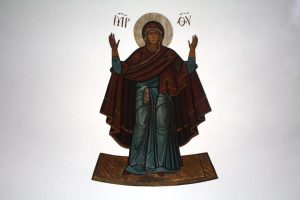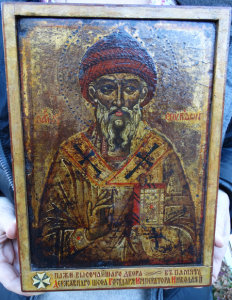The Church - History
Dedicated to Saint Job, the Biblical Saint, whose steadfast faith the Lord wanted to test through, the church is dedicated to the memory of the last Tsar of Russia, the Emperor Nicholas II, whose date of birth coincides with the feast of Saint Job , and that of the Imperial family, massacred by the communist power on July 17, 1918.
The church also aims to be a memorial to the victims of the revolution and civil war in Russia, who have fallen since the takeover by the Bolsheviks in October 1917.
This intention is evoked by the four large memorial plaques to the left and right of the iconostasis. Two places on the right side name the members of the murdered Imperial family, while those on the left side are dedicated to the clergy, the monks, and to all the victims "whose names the Lord knows."
Around the altar, plaques built into the wall bear the names of more than one hundred and twenty bishops tortured and put to death by the communists.

Other nameplates that adorn the walls of the church were placed at the request of a number of families who tragically lost one of their members during the Revolution and Civil War 1917-1921, most of whom did not receive a Christian burial.
The initiative to build the church dates back to 1929 and it was in this same year that fundraising began among Russian emigrants all over the world to finance its construction and furnishing. The royal houses of Yugoslavia and Bulgaria have also responded to the call, as has the municipality of Uccle.
The project was designed by a committee of architects specialized in the history of Russian religious architecture, chaired by Prof. Okouneff from the University of Prague. All drawings were made by the architect-painter Nicolas Iselenov who was also responsible for overseeing the execution of all the artistic details of the project. Nicolas Iselenov is also the painter of some icons kept in the church.
The foundation stone was laid in 1936; in 1939 the works were almost complete. After an interruption due to World War II, work was resumed in 1946 and the solemn consecration of the church took place on October 1, 1950.
The church is under the jurisdiction of the Synod of Bishops of the Russian Orthodox Church Abroad which is headquartered in New York, United States.
The Orthodox Church was recognized by the Belgian State in May 1985.
The Church - Architecture
The architecture of the church is inspired by a famous model of the Russian religious architecture of the sixteenth century, in the old Russian style of Moscow: one of the two chapels of the Cathedral of the Transfiguration of Christ in the village of Ostrov, pictured below.
The church is connected to the building – bell tower by a small room executed in 1975. The church also aims to be a memorial to the victims of the revolution and civil war in Russia, who have fallen since the takeover by the Bolsheviks in October 1917.
Significant restoration works ( see the photos) subsidized by the Ministry of Monuments and Sites of the Brussels-Capital Region were carried out from 2011-2012.
The Church - Iconography
Inside the church, the iconostasis, border between the sanctuary and the nave, is covered with traditional icons painted in the style of the sixteenth century by one of the best painters of icons of Paris, the Princess Lvov.
On the left are the Most Holy Mother of God, Archangel Michael and Saint Andre Bogoliubov whose feast day coincides with the day of the assassination of the Imperial family.
In the second row, twelve icons represent the feasts of the Orthodox ecclesiastical year and finally in the third row, on either side of the central statue of the Redeemer, next to the Mother of God and the apostles Peter and Paul, are some of the greatest saints. of the Russian Orthodox Church.
Most of the icons were donated by private individuals in the memory of their relatives whose names are on the back of each icon. The fresco of the Holy Mother of God "Orante", painted in the apse, is the work of Nicolas Iselenov.
On the right side of the iconostasis, a hatch of icons (kiot) gathers around the symbol of the Most Holy Mother of God Feodorovskaya, patroness of the House of Romanoff, icons with the surnames of all members of the Imperial family.
To the left of the iconostasis, a large triptych painted by Archimandrite Cyprian, represents all the saints of Russia. This icon was painted long before the canonization of the Imperial Family and of all new Martyrs of Russia by the Russian Orthodox Church outside the borders in 1981.
![]()
The iconostasis separates the altar from the middle part of the Temple, icons in the style of the 16th century. In addition to the Royal Gates, the icons were painted by the famous icon painter Princess Lvova from Paris. Most of the icons were donated in memory of the deceased family members of individuals, their names are written on the back of the icon.

The icons of the Royal Doors of the Annunciation and the four Evangelists were painted by N.I. Healed, architect of the Temple. Above the Royal Doors the icon of the Last Supper
![]()
To the right of the Royal Doors are the icons of Christ the Savior, the Archangel Gabriel and St. Job, whose feast coincides with the birthday of Emperor Nicholas II
![]()
To the left of the Royal Doors are the icons of the Mother of God, the Archangel Michael and St. Andrew Bogolyubsky, whose feast coincides with the day of the murder of the Royal Family.

Above the altar "Indestructible Wall", a fresco painted by N.I. Healed. a copy of the mosaic of St. Sophia Cathedral in Kyiv.

To the right of the iconostasis is a large icon with the icon of the Feodorovskaya Mother of God, Patroness of the House of Romanov, with the icon of the Resurrection of Christ and on the sides of the icon of the Heavenly Patrons of the members of the Royal Family.

To the left of the iconostasis is a large foldable of Father Archimandrite Cyprian "All the Saints in the Russian Land Resplendent" on the left in the foldable "Baptism of Russia" on the right side of the "New Martyrs of Russia".
This book was written before the glorification of the Royal Family and the New Martyrs by the Church Abroad in 1981.


In the second row there are twelve icons of the twelfth holidays.
| 1 | Praise of the Virgin |
| 2 | Nativity of the Blessed Virgin Mary |
| 3 | Annunciation of the Blessed Virgin Mary |
| 4 | Leading to the Church of the Most Holy Theotokos |
| 5 | Assumption of the Blessed Virgin Mary |
| 6 | Protection of the Holy Mother of God |
| 7 | Sunday |
| 8 | Calvary |
| 9 | Transfiguration |
| 10 | Entry of the Lord into Jerusalem |
| 11 | Baptism |
| 12 | Christmas |



| In the third row of the icon of the Savior, the Mother of God, the Forerunner and Baptist of the Lord John, the Apostles Peter and Paul and the main saints of the Russian Orthodox Church. |
| 1 | St. Alexander Nevsky |
| 2 | St. great martyr Panteleimon |
| 3 | St. John the Evangelist |
| 4 | Apostle Peter |
| 5 | Archangel Michael |
| 6 | Mother of God |
| 7 | Savior |
| 8 | John the Baptist |
| 9 | Archangel Gabriel |
| 10 | Apostle Paul |
| 11 | St. Nicholas |
| 12 |
St. George the Victorious |
| 13 | St. Vladimir |
iconography - Icons

Icon of St. Spyridon Trimifuntsky
Our parishioners noticed that the icon of St. Spyridon was cleansed, St. Spyridon (270-348) was the bishop of the city of Trimifunt in Cyprus in the 4th century. At the beginning of his life he was a shepherd, then, according to legend, a bishop, a participant in the Council of Nicaea (325). Since 1456 his relics rest in Corfu, and his right hand in Rome.
Many miracles are attributed to him, such as, for example, in times of famine, he helped a poor peasant who did not have anything to pay wheat (zhito) for food. He turned to the rich man, promising to repay the debt with interest after the harvest, but he demanded gold on the security of this zhit. Then the peasant called for the help of St. Spyridon, and he, having no money himself, turned the snake into gold.
The peasant was able to buy wheat from the rich man. And immediately after the harvest, the peasant bought the gold and returned it to the saint, who turned the gold back into a snake. Among others, this miracle is mentioned in the troparion to the saint: "Thou hast turned the serpent into gold."
The icon was donated to the church by former pupils of the Corps of Pages, a St. Petersburg military school founded on December 12, 1802. (according to the old style) on the day of St. Spiridon. The Page Corps was located in the Vorontsov Palace - the residence of the Knights of Malta under Paul the First, who became the Grand Master of the Order of Malta after the order was expelled from Malta. That is why the Maltese cross - it was worn on the form of pupils - is listed on the bottom of the icon.
Saint Spyridon is celebrated on December 12/25.


